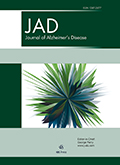Authors: Zhang, Cheng | Kuo, Ching-Chang | Moghadam, Setareh H. | Monte, Louise | Rice, Kenner C. | Rissman, Robert A.
Article Type:
Research Article
Abstract:
Reports from Alzheimer's disease (AD) biomarker work have shown a strong link between oxidative stress and AD neuropathology. The nonenzymatic antioxidant, glutathione (GSH), plays a crucial role in defense against reactive oxygen species and maintenance of GSH redox homeostasis. In particular, our previous studies on GSH redox imbalance have implicated oxidative stress induced by excessive reactive oxygen species as a major mediator of AD-like events, with the presence of S-glutathionylated proteins (Pr-SSG) appearing prior to overt AD neuropathology. Furthermore, evidence suggests that oxidative stress may be associated with dysfunction of the hypothalamic-pituitary-adrenal axis, leading to activation of inflammatory pathways and
…increased production of corticotropin-releasing factor (CRF). Therefore, to investigate whether oxidative insults can be attenuated by reduction of central CRF signaling, we administered the type-1 CRF receptor (CRFR1) selective antagonist, R121919, to AD-transgenic mice beginning in the preclinical/prepathologic period (30-day-old) for 150 days, a timepoint where behavioral impairments and pathologic progression should be measureable. Our results indicate that R121919 treatment can significantly reduce Pr-SSG levels and increase glutathione peroxide activity, suggesting that interference of CRFR1 signaling may be useful as a preventative therapy for combating oxidative stress in AD.
Show more
Keywords: Alzheimer's disease, corticotropin-releasing factor-1 receptor (CRFR1), glutathione, glutathione peroxide, glutathione reductase, oxidative stress, oxidized glutathione, R121919, S-glutathionylated protein
DOI: 10.3233/JAD-141722
Citation: Journal of Alzheimer's Disease,
vol. 45, no. 2, pp. 639-650, 2015
Price: EUR 27.50




